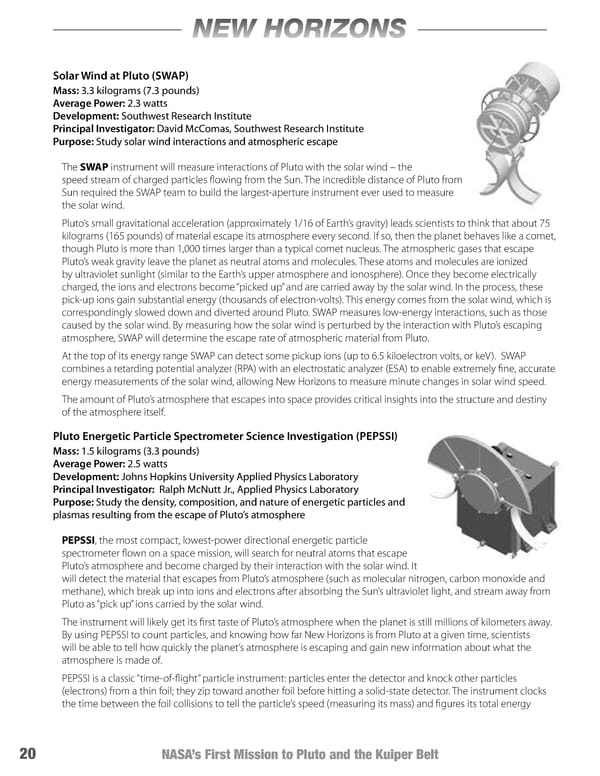NEW HORIZONS Solar Wind at Pluto (SWAP) Mass: 3.3 kilograms (7.3 pounds) Average Power: 2.3 watts Development: Southwest Research Institute Principal Investigator: David McComas, Southwest Research Institute Purpose: Study solar wind interactions and atmospheric escape The SWAP instrument will measure interactions of Pluto with the solar wind – the high- speed stream of charged particles flowing from the Sun. The incredible distance of Pluto from the Sun required the SWAP team to build the largest-aperture instrument ever used to measure the solar wind. Pluto’s small gravitational acceleration (approximately 1/16 of Earth’s gravity) leads scientists to think that about 75 kilograms (165 pounds) of material escape its atmosphere every second. If so, then the planet behaves like a comet, though Pluto is more than 1,000 times larger than a typical comet nucleus. The atmospheric gases that escape Pluto’s weak gravity leave the planet as neutral atoms and molecules. These atoms and molecules are ionized by ultraviolet sunlight (similar to the Earth’s upper atmosphere and ionosphere). Once they become electrically charged, the ions and electrons become “picked up” and are carried away by the solar wind. In the process, these pick-up ions gain substantial energy (thousands of electron-volts). This energy comes from the solar wind, which is correspondingly slowed down and diverted around Pluto. SWAP measures low-energy interactions, such as those caused by the solar wind. By measuring how the solar wind is perturbed by the interaction with Pluto’s escaping atmosphere, SWAP will determine the escape rate of atmospheric material from Pluto. At the top of its energy range SWAP can detect some pickup ions (up to 6.5 kiloelectron volts, or keV). SWAP combines a retarding potential analyzer (RPA) with an electrostatic analyzer (ESA) to enable extremely fine, accurate energy measurements of the solar wind, allowing New Horizons to measure minute changes in solar wind speed. The amount of Pluto’s atmosphere that escapes into space provides critical insights into the structure and destiny of the atmosphere itself. Pluto Energetic Particle Spectrometer Science Investigation (PEPSSI) Mass: 1.5 kilograms (3.3 pounds) Average Power: 2.5 watts Development: Johns Hopkins University Applied Physics Laboratory Principal Investigator: Ralph McNutt Jr., Applied Physics Laboratory Purpose: Study the density, composition, and nature of energetic particles and plasmas resulting from the escape of Pluto’s atmosphere PEPSSI, the most compact, lowest-power directional energetic particle spectrometer flown on a space mission, will search for neutral atoms that escape Pluto’s atmosphere and become charged by their interaction with the solar wind. It will detect the material that escapes from Pluto’s atmosphere (such as molecular nitrogen, carbon monoxide and methane), which break up into ions and electrons after absorbing the Sun’s ultraviolet light, and stream away from Pluto as “pick up” ions carried by the solar wind. The instrument will likely get its first taste of Pluto’s atmosphere when the planet is still millions of kilometers away. By using PEPSSI to count particles, and knowing how far New Horizons is from Pluto at a given time, scientists will be able to tell how quickly the planet’s atmosphere is escaping and gain new information about what the atmosphere is made of. PEPSSI is a classic “time-of-flight” particle instrument: particles enter the detector and knock other particles (electrons) from a thin foil; they zip toward another foil before hitting a solid-state detector. The instrument clocks the time between the foil collisions to tell the particle’s speed (measuring its mass) and figures its total energy 20 NASA’s First Mission to Pluto and the Kuiper Belt
 New Horizons Page 28 Page 30
New Horizons Page 28 Page 30